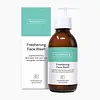What's inside
What's inside
 Key Ingredients
Key Ingredients

 Benefits
Benefits

 Concerns
Concerns

No concerns
 Ingredients Side-by-side
Ingredients Side-by-side

Water
Skin ConditioningDisodium Cocoyl Glutamate
CleansingNiacinamide
SmoothingGlycerin
HumectantDisodium Cocoamphodiacetate
CleansingDecyl Glucoside
CleansingXanthan Gum
EmulsifyingSodium Hyaluronate
HumectantMyrciaria Dubia Fruit Extract
Skin ConditioningSodium Ascorbyl Phosphate
AntioxidantPhenoxyethanol
PreservativeCitric Acid
BufferingEthylhexylglycerin
Skin ConditioningPotassium Sorbate
PreservativeTocopherol
AntioxidantWater
Skin ConditioningPropanediol
SolventSodium Lauroyl Sarcosinate
CleansingGlycerin
HumectantHydroxypropyl Methylcellulose
Emulsion StabilisingSodium Anisate
AntimicrobialSodium Levulinate
Skin ConditioningAloe Barbadensis Leaf Juice
Skin ConditioningLactic Acid
BufferingPolyglyceryl-6 Caprylate
EmulsifyingPolyglyceryl-3 Cocoate
EmulsifyingPolyglyceryl-3 Caprate
EmulsifyingPolyglyceryl-6 Ricinoleate
EmulsifyingCitrus Aurantium Bergamia Peel Oil 0.136%
Sodium Phytate
Xanthan Gum
EmulsifyingCamellia Sinensis Leaf Extract
AntimicrobialWater, Propanediol, Sodium Lauroyl Sarcosinate, Glycerin, Hydroxypropyl Methylcellulose, Sodium Anisate, Sodium Levulinate, Aloe Barbadensis Leaf Juice, Lactic Acid, Polyglyceryl-6 Caprylate, Polyglyceryl-3 Cocoate, Polyglyceryl-3 Caprate, Polyglyceryl-6 Ricinoleate, Citrus Aurantium Bergamia Peel Oil 0.136%, Sodium Phytate, Xanthan Gum, Camellia Sinensis Leaf Extract
 Reviews
Reviews

Ingredients Explained
These ingredients are found in both products.
Ingredients higher up in an ingredient list are typically present in a larger amount.
Glycerin is already naturally found in your skin. It helps moisturize and protect your skin.
A study from 2016 found glycerin to be more effective as a humectant than AHAs and hyaluronic acid.
As a humectant, it helps the skin stay hydrated by pulling moisture to your skin. The low molecular weight of glycerin allows it to pull moisture into the deeper layers of your skin.
Hydrated skin improves your skin barrier; Your skin barrier helps protect against irritants and bacteria.
Glycerin has also been found to have antimicrobial and antiviral properties. Due to these properties, glycerin is often used in wound and burn treatments.
In cosmetics, glycerin is usually derived from plants such as soybean or palm. However, it can also be sourced from animals, such as tallow or animal fat.
This ingredient is organic, colorless, odorless, and non-toxic.
Glycerin is the name for this ingredient in American English. British English uses Glycerol/Glycerine.
Learn more about GlycerinWater. It's the most common cosmetic ingredient of all. You'll usually see it at the top of ingredient lists, meaning that it makes up the largest part of the product.
So why is it so popular? Water most often acts as a solvent - this means that it helps dissolve other ingredients into the formulation.
You'll also recognize water as that liquid we all need to stay alive. If you see this, drink a glass of water. Stay hydrated!
Learn more about WaterXanthan gum is used as a stabilizer and thickener within cosmetic products. It helps give products a sticky, thick feeling - preventing them from being too runny.
On the technical side of things, xanthan gum is a polysaccharide - a combination consisting of multiple sugar molecules bonded together.
Xanthan gum is a pretty common and great ingredient. It is a natural, non-toxic, non-irritating ingredient that is also commonly used in food products.
Learn more about Xanthan Gum